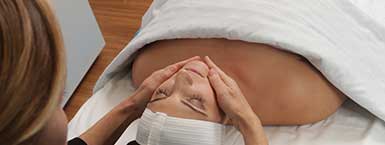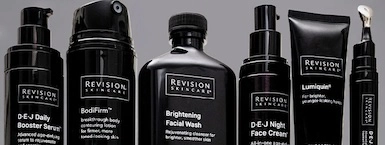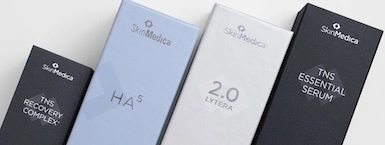Deep Blue Med Spa is proud to offer customized treatment for reticular veins and telangiectasias, more commonly known as spider veins, to patients in Long Island, NYC, Manhattan, and Garden City. Overseen by the plastic surgeons at New York Plastic Surgical Group, our effective treatments are performed by highly trained Physician Assistants who are skincare and vein specialists and have significant experience combining minimally invasive treatments like sclerotherapy and laser therapy for optimal results.
Spider Vein
Therapy
Page Updated:

What Are Spider Veins?
Spider veins, also known as telangiectasias, are small, dilated blood vessels that appear close to the surface of the skin.1 They are usually red, blue, or purple and commonly form on the legs and face. These veins can resemble a spider web or tree branches and are often caused by factors such as genetics, weakened vein valves, prolonged standing, hormonal changes, or sun exposure. While generally harmless, spider veins can sometimes cause discomfort or cosmetic concerns, leading individuals to seek treatments like sclerotherapy or laser therapy for removal.
Reticular Veins
Reticular veins, also known as feeder veins, are medium-sized veins that lie beneath the surface of the skin and are typically blue or green in color. They are larger than spider veins but smaller than varicose veins and often form a network that feeds into spider veins. Reticular veins are usually found on the legs and face and can sometimes cause discomfort or a burning sensation. While primarily a cosmetic concern, they can be treated with procedures such as sclerotherapy or laser therapy to improve appearance and alleviate any associated symptoms.
How to Prepare for Spider Vein Removal
Preparing for vein treatment involves several key steps to ensure the best outcomes. Patients should consult with their healthcare provider to discuss their medical history, current medications, and any allergies. It’s important to avoid certain medications like aspirin and other blood thinners a few days before the procedure to minimize the risk of bleeding. Wearing loose, comfortable clothing to the appointment is recommended, as well as arranging transportation if sedation will be used. Patients should also follow any specific instructions given by their doctor, such as fasting or hydrating adequately before the treatment.
Vein Removal Options
A successful treatment program requires treating both the reticular and telangiectasias since spider veins will not respond well to treatment until the reticular veins are addressed.
Sclerotherapy
Sclerotherapy is a common and effective treatment for spider vein removal, involving the injection of a sclerosant solution directly into the treated vein.2 This solution irritates the vein walls, causing them to collapse and eventually be reabsorbed by the body, resulting in the disappearance of the veins. The procedure is minimally invasive, typically takes less than an hour, and requires no anesthesia. Most patients experience minimal discomfort and can return to normal activities shortly after treatment. While the risk is low, potential complications can include clots forming in the treated vein. Multiple sessions may be needed for optimal results, depending on the extent of the spider veins.
Laser Therapy
Laser vein ablation is virtually painless and effectively treats small spider veins. Our Physician Assistants use a cutting-edge laser that emits controlled pulses of light to the targeted area of veins. The light from the laser is absorbed by the red blood cells in the spider vein and causes the vein to be damaged. The damaged veins ultimately collapse and are reabsorbed by the body. Through a combined treatment program of sclerotherapy and laser therapy, the deep-colored veins that were once unpleasant will fade in appearance, and the symptoms of discomfort will fade.
Vein Removal Recovery
Recovery from vein removal treatment typically involves some straightforward aftercare steps to promote healing and reduce discomfort. Patients are advised to wear compression stockings as directed by their healthcare provider to support blood flow and minimize swelling. Light activities and walking are encouraged to enhance circulation, but strenuous exercise and heavy lifting should be avoided for a few days. It’s normal to experience some bruising, swelling, or mild discomfort at the treatment site, which usually resolves within a week or two. Following post-procedure instructions, including keeping the treated area clean and dry, is crucial for optimal recovery.

How does Vein Therapy work?
- A combination of a laser treatment and tiny needles that inject a solution to minimize the appearance of the vein.
Is Vein Therapy right for me?
- Do you have reticular veins (blue veins) and/or telangiectasias (spider veins)?
- Maybe used to treat unwanted cosmetic veins

Experience Vein Therapy with PRO-NOX™
PRO-NOX is a nitrous oxide delivery system for fast-acting pain relief. It increases comfort and aids in calming anxiety.
What Do I Need To Know About Vein Therapy?
BEFORE:
- Consultations are available at all Deep Blue Med Spa locations.
- Purchase compression stockings.
- 2-3 or more treatments may be necessary to achieve desired result.
- Little to no downtime required.
- Avoid aspirin, ibuprofen, blood thinners, and fish oil for 14 days prior to treatment.
AFTER:
- Compression stockings must be worn 2-5 days after treatment.
- No exercise for a week but walking is encouraged.
- Arnica is necessary to minimize bruising.
*Individual Results May Vary
FAQs About Spider Veins
What’s the difference between spider veins and varicose veins?
Spider veins, varicose veins, and reticular veins differ in appearance and severity. Spider veins are small, red, blue, or purple vessels that appear close to the skin’s surface in a web-like pattern, typically on the legs and face. Varicose veins are larger, swollen, and twisted veins that are often blue or flesh-colored, bulging above the skin, and commonly found in the legs; they can cause pain and swelling.
Do vein treatments have any side effects?
Yes, both sclerotherapy and laser therapy for spider veins can have side effects. Common side effects of sclerotherapy include bruising, redness, swelling, and mild pain at the injection site, as well as the potential for small skin sores or discoloration. Laser therapy can cause temporary skin redness, swelling, and a sensation similar to a sunburn. During your consultation, your vein specialists will discuss any risks with you before scheduling treatment.
How many treatment sessions will I need?
The number of treatment sessions required for spider vein treatment varies based on the severity of veins being treated, as well as the chosen treatment method. During your initial consultation, your provider will evaluate your condition and develop a personalized treatment plan. Typically, patients require 2-3 sessions to achieve optimal results.3 Your treatment plan will outline the expected number of sessions, the intervals between them, and any necessary follow-up care to ensure the best possible outcomes.

Schedule Your Appointment
Contact us for details on vein care at one of our medical spas in Long Island, Manhattan, NYC, or Garden City, or to schedule your appointment with one of our vascular specialists.
Sources
Cleveland Clinic. Spider Veins. https://my.clevelandclinic.org/health/diseases/24567-spider-veins. Accessed August 12, 2024.
StatPearls. Spider Veins. https://www.ncbi.nlm.nih.gov/books/NBK563218/. Accessed August 12, 2024.
Aad. Leg Veins: Why They Appear And How Dermatologists Treat Them. https://www.aad.org/public/cosmetic/younger-looking/how-dermatologists-treat-leg-veins#. Accessed August 12, 2024.
Medical Spa SPECIALS
The Medical Professionals at Deep Blue Med Spa have either authored or reviewed and approved this content.






















